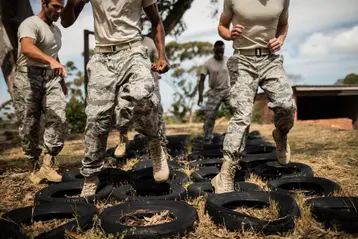
I have worked in leadership roles for a very long time and worked under other leaders even longer. I am sometimes asked for my thoughts on what makes someone a great leader.
As anyone who is a great leader or has worked for one knows, there are many characteristics that take someone beyond being an everyday people manager to being someone who leads their team in a way that can be categorized as “great.”
I won’t tell you everything you need to know about leadership in this post because 1) it would take far too much room and 2) I am continuously learning it myself. But I would like to share one very important characteristic that all future leaders must cultivate early-on if they truly want to be great.
That characteristic is perseverance. It is one of the hardest traits to master and one of the most rewarding. To really get to the heart of the relationship between perseverance and leadership, I called on an old friend named Lanny.
Meet Lanny Smith
Some of the greatest professional and personal pleasures I have are my conversations with Robert Land “Lanny” Smith. Lanny is a retired U.S. Army Colonel who has also held positions at the revered U.S. Military Academy at West Point as both a deputy commandant and a teacher of history.
I am lucky to call Lanny a friend and mentor. Much of my early success as a leader can be attributed to Lanny’s teachings. And most of Lanny’s teachings come from his time serving with the U.S. military.
If you are a new manager, seasoned leader or somewhere in between and you would like advice on how to lead more effectively, motivate your team, improve efficacy or overcome any of the roadblocks that nearly all leaders face, Lanny can provide a lesson that is rooted in military strength.
Because we can’t all call Lanny for help (I promised him I wouldn’t publish his phone number), I have compiled some of his most poignant teachings that have helped me through my career and am sharing these in a series of posts under the title of “Leadership Lessons with Lanny.”
This is the first post in the series. Here is what Lanny—and the U.S. military—have to say about perseverance.
Meet General Freddy Franks
General Frederick M. Franks, a 1959 graduate of West Point and decorated war hero, lost his left leg, just below the knee, to a North Vietnamese grenade during the Invasion of Cambodia in May 1970. At the time, he was serving as an operations officer for the 2nd Squadron of the 11th Armored Cavalry Regiment.
After a series of painful surgeries, each followed by months of rehabilitation, most expected that Franks would be done serving. However, Franks did the unexpected and returned to active duty in February 1972. Quitting wasn’t in his nature and he wasn’t going to let a small thing like missing half his leg keep him from getting the job done.
Lanny later met Franks when they were stationed together in Germany in 1990. He remembers watching Franks strap on his prosthetic leg before a unit run at the training center on Grafenwohr Army Base. “He was tough as nails and expected all his troops to be just as tough,” says Lanny. “Although the pain was tremendous, Franks never skipped a run and never dropped out during one.”
In 1991, Lanny was part of Franks’ famous “left hook” maneuver in which four U.S. divisions and one British armored corps defeated 14 Iraqi divisions. In 89 hours of continuous operations, Franks and his troops travelled more than 250 kilometers to decimate the third largest army in the world—and they did so with relatively few U.S. casualties. Where other officers may have retreated or other troops may have dropped from exhaustion, Franks and his command plowed ahead. Franks’ persistence played a significant role in the outcome of the war.
What is important about Freddy Franks’ unwavering dedication to getting the job done, no matter what the hurdle, isn’t just in the example he set for his troops—an example that any good soldier would be wise to emulate. It’s not in the fact that if any of us fight hard and long enough, we’ll eventually either succeed or die. It’s that, through the sheer act of pushing forward, even when lesser individuals would have given up, Freddy created himself into a strong leader.
Every time Freddy felt physical pain and powered through it…every time he wanted with every fiber of his being to stop but then looked at his troops and knew he had to keep going...every time he was met with someone who told him to just go home and live with his injuries…all of this brought him to that day of the Gulf War, when nothing less than a miracle could save him from certain defeat.
All the perseverance that Freddy had built up in himself through his career led him to that day when he would either win or lose a war for his country. And on that day, Freddy said “bring it.”
Then he and his command persevered.
Meet Marty Stowe
Lanny’s story of Freddy Franks served as an inspiration to me when I was faced with what was the single toughest experience of my whole career and one of the toughest of my entire life.
At the time, I was working for a large public corporation that kept me very busy running our entire New England territory. Then, within a period of six months, we acquired two of our staunchest competitors. Each of these acquisitions seemingly happened overnight. When I say they happened overnight, I mean on Friday the acquired business was our arch enemy and on Monday we were all one company. And this happened to me twice in half a year.
As anyone who has ever gone through a merger knows, the biggest challenge is in integrating different cultures, employees, clients, technology, payroll platforms and myriad other things you wouldn’t even think of. Because these two companies had been headquartered in my New England territory, the job of unifying three separate companies into one corporate family fell squarely on my shoulders.
It was something I was expected to do, by the way, in addition to my already very busy day job—and with very little experience managing a merger. It was also in addition to my duties as a husband and a father to two very young children.
To say I was overwhelmed was an understatement.
But if Freddy Franks could get his team through a war with only ¾ of his legs, I could get mine through a couple of acquisitions.
So I jumped into action. First thing on the Monday morning of each merger, our major clients and employees from the acquired companies found a floral arrangement from me, welcoming them to the company. I deleted words like “acquisition” and “acquire” from my lexicon and only said words like “merge” or “blend” when speaking to my team.
Because I had to work every weekend for nine months in order to stay on top of the workload, I made a schedule where I got up at 4 a.m. every Saturday and Sunday, put in a half-day at the office before 9 a.m. and then got home before my kids had even changed out of their footie pajamas.
The only holidays I took that year were Thanksgiving and Christmas. When I started, I had no idea when this torture would end but I knew I had to plow through until it did.
I would be lying if I said I wasn’t tempted every day to give up—to resign and find a job that only required 50 or 60 hours of work a week. But I had a commitment to the company and, most importantly, to my team, who were also working very hard to make sure things went smoothly. To fail in my job would be to fail them. And that is not what a leader does.
So I persevered.
What I didn’t realize at the time--when I barely could find a minute to eat or shave, much less reflect--was that I was shaping my own character. Through this hellacious merger boot camp, I was becoming the type of leader I wanted to be.
And once the dust settled, the smoke cleared and things evened out into one productive, happy corporate culture, I finally did get that chance to reflect. And I realized something important: My team and I had totally kicked butt.
Because we had managed to retain nearly all our new employees and clients through two mergers, Wall Street responded very positively to our success. We were used as a best practices example to show how to merge companies efficiently. As a corporation, we were shining. As a team, we were running smoother than ever. Our board, CEO and CFO couldn’t have been happier. As an individual, it put my name in lights. I became a fast-tracker in the company and rose to a much higher level of management.
And the one thing I did that was the difference between career failure and what became the catalyst to where I am today is simply this: I didn’t throw in the towel. Even when the desire to was overwhelming. Even when I didn’t know if the sacrifice would ever be worth the pay-out. Even when there was no end in sight. Even when crawling out of bed at 4 a.m. for the 100th time felt impossible. I never gave up.
And, boy, did I want to. But I persisted and it paid off.
Meet Your Future Leaders
As business leaders, we all want employees who approach challenges with tenacity and are relentless in finding solutions. But more than being good for your company’s mission and the bottom line, these employees also have strong leadership potential.
As you think about the future of your business and who you want in charge of your teams, look for those employees who are facing even the biggest challenges head-on, finding innovative solutions and working through them without giving up. Even if they continuously get knocked down, watch how often they get up. These are the people worth the investment in developing as they are the ones who have the persistence required to lead your company to greatness.
What about you? Tell us about a time you persisted as a leader to great benefit or about a leader you know who displays great persistence.
This communication is for informational purposes only; it is not legal, tax or accounting advice; and is not an offer to sell, buy or procure insurance.



